Land Suitability Planning for Sustainable Mango Production in Vulnerable Region Using Geospatial Multi-Criteria Decision Model
Abstract
:1. Introduction
2. Materials and Methods
2.1. Study Area
2.2. Satellite Data
2.3. Data Collection from Field
2.4. Method
2.4.1. Multi-Criteria Decision Making (MCDM)
2.4.2. Analytical Hierarchy Process (AHP)
2.4.3. Sensitivity Analysis (SA)
3. Results and Discussion
3.1. Preparation of Various Thematic Maps
3.1.1. Land Use/Land Cover Map
3.1.2. Slope Suitability
3.1.3. Soil Suitability
3.1.4. Climate Suitability
3.1.5. Soil Loss and Carbon Loss Suitability
3.1.6. Soil and Water Conservation Measures
3.1.7. Carbon Sequestration
3.2. Mango Crop Suitability Map Using AHP
3.2.1. Mango Climate Suitability Map
3.2.2. Mango Soil Suitability Map
3.2.3. Mango Erosion Hazards Suitability Map
3.2.4. Mango Conservation Measure Suitability Map
3.2.5. Overall Mango Suitability Map Using Main Criteria
3.3. Sensitivity Analysis
3.3.1. Before Adoption of Soil and Water Conservation (SWC)
3.3.2. Overall Mango Land Suitability Map Using Sensitivity Analysis
3.4. Accuracy Assessment
3.5. Spatial Variation in Soil Loss after Implementation of SWC
3.5.1. Sensitivity Analysis after Implementation of SWC
3.5.2. Overall Mango Land Suitability Map (after Implementation of SWC)
4. Conclusions
Author Contributions
Funding
Institutional Review Board Statement
Informed Consent Statement
Data Availability Statement
Acknowledgments
Conflicts of Interest
References
- Mandal, D.; Giri, N.; Srivastava, P. The magnitude of erosion-induced carbon (C) flux and C-sequestration potential of eroded lands in India. Eur. J. Soil Sci. 2020, 71, 151–168. [Google Scholar] [CrossRef]
- Durbude, D. Hydrological impact assessment of SWC measures in Ralegon Siddhi model watershed. Indian J. Soil Conserv. 2015, 43, 197–203. [Google Scholar]
- Nandgude, S.B.; Mahale, D.M.; Jagtap, D.N.; Rane, A.D.; Patil, V.K.; Hardikar, D.P.; Salunkhe, S.S.; Bandgar, N.N.; Mohite, N.S.; Phadtare, M.A.; et al. Natural Resources Atlas of Konkan; DBSKKV: Dapoli, India, 2018. [Google Scholar]
- Lal, R. Soil Erosion and Gaseous Emissions. Appl. Sci. 2020, 10, 2784. [Google Scholar] [CrossRef]
- Chavan, S.B.; Dhillon, R.S.; Rizvi, R.H.; Sirohi, C.; Handa, A.K.; Bharadwaj, K.K.; Johar, V.; Kumar, T.; Singh, P.; Daneva, V.; et al. Estimating biomass production and carbon sequestration of poplar-based agroforestry systems in India. Environ. Dev. Sustain. 2022, 24, 13493–13521. [Google Scholar] [CrossRef]
- Ravindranath, N.H.; Somashekhar, B.S.; Gadgil, M. Carbon flow in Indian forests. Clim. Change 1997, 35, 297–320. [Google Scholar] [CrossRef]
- Zade, S.P.; Bhosale, S.L.; Gourkhede, P.H. Carbon Status in Major Fruit Orchard Soils of Parbhani District of Maharashtra. Int. J. Curr. Microbiol. App. Sci. 2020, 9, 1969–1979. [Google Scholar] [CrossRef]
- Patil, P.; Kumar, A.K. Biological carbon sequestration through fruit crops (perennial crops—Natural “sponges” for absorbing carbon dioxide from atmosphere). Plant Arch. 2017, 17, 1041–1046. [Google Scholar]
- Fahad, S.; Chavan, S.B.; Chichaghare, A.R.; Uthappa, A.R.; Kumar, M.; Kakade, V.; Pradhan, A.; Jinger, D.; Rawale, G.; Yadav, D.K.; et al. Agroforestry Systems for Soil Health Improvement and Maintenance. Sustainability 2022, 14, 14877. [Google Scholar] [CrossRef]
- Bagherzadeh, A.; Ghadiri, E.; Darban, R.S.; Gholizadeh, A. Land suitability modeling by parametric-based neural networks and fuzzy methods for soybean production in a semi-arid region. Model. Earth Syst. Environ. 2016, 2, 104. [Google Scholar] [CrossRef]
- FAO. A Framework for Land Evaluation: Soils Bulletin 32; Food and Agriculture Organization of the United Nations: Rome, Italy, 1976. [Google Scholar]
- Elaalem, M. Land suitability evaluation for sorghum based on boolean and fuzzy-multi-criteria decision analysis methods. Int. J. Environ. Sci. Dev. 2012, 3, 357–361. [Google Scholar] [CrossRef]
- Gigovic, L.; Pamucar, D.; Bajic, Z.; Drobnjak, S. Application of GIS-interval rough AHP methodology for flood hazard mapping in urban areas. Water 2017, 9, 360. [Google Scholar] [CrossRef]
- Malczewski, J.; Rinner, C. Multi-Criteria Decision Analysis in Geographic Information Science; Springer Science: New York, NY, USA, 2015. [Google Scholar]
- Din, G.Y.; Yunusova, A.B. Using AHP for evaluation of criteria for agro-industrial projects. Int. J. Hortic. Agric. 2016, 1, 6. [Google Scholar] [CrossRef]
- Ramamurthy, V.; Reddy, G.P.O.; Kumar, N. Assessment of land suitability for maize (Zea mays L.) in semi-arid ecosystem of southern India using integrated AHP and GIS approach. Comput. Electron. Agric. 2020, 179, 105806. [Google Scholar] [CrossRef]
- Kahsay, A.; Haile, M.; Gebresamuel, G.; Mohammed, M. Land suitability analysis for sorghum crop production in northern semi-arid Ethiopia: Application of GIS-based fuzzy AHP approach. Cogent Food Agric. 2018, 4, 1–24. [Google Scholar] [CrossRef]
- Prakash, T.N. Land Suitability Analysis for Agricultural Crops: A fuzzy Multi-Criteria Decision Making Approach. Master’s Thesis, ITC, Enchede, The Netherlands, 2003. [Google Scholar]
- Thakor, N. Indian mango–production and export scenario. Adv. Agric. Res. Technol. J. 2019, 3, 80–88. [Google Scholar]
- Indian Horticulture Database–2014. Chief Editor Mamta Saxena Advisor (Horticulture) Deptt. of Agri. & Coop. Available online: https://nhb.gov.in/area-pro/NHB_Database_2015.pdf (accessed on 6 December 2022).
- Ganeshamurthy, A.N.; Rupa, T.R.; Shivananda, T.N. Enhancing Mango Productivity through Sustainable Resource Management. J. Horti. Sci. 2018, 1, 1–31. [Google Scholar]
- Ganeshamurthy, A.N.; Ravindra, V.; Rupa, T.R.; Bhatt, R.M. Carbon sequestration potential of mango orchards in the tropical hot and humid climate of Konkan region, India. Curr. Sci. 2019, 8, 1417–1423. [Google Scholar] [CrossRef]
- Burondkar, M.M.; Kulkarni, M.M.; Salvi, B.R.; Patil, K.D.; Narangalkar, A.L.; Talathi, J.M.; Naik, V.G.; Malave, D.B.; Bhosale, S.S.; Deorukhakar, A.C.; et al. Mango: An Economic Pillar of Konkan Region of Maharashtra. Adv. Agric. Res. Technol. J. 2018, 2, 160–170. [Google Scholar]
- Chitale, V.S.; Behera, M.D.; Roy, P.S. Global biodiversity hotspots in India: Significant yet under studied. Curr. Sci. 2015, 108, 149–150. [Google Scholar]
- Naidu, L.G.K.; Srinivas, S.; Reddy, G.S.; Kumar, S.C.R.; Reddy, R.S. Identification and delineation of suitable areas for mango, banana, citrus and cashew crops in Andhra Pradesh. Agropedology 2009, 19, 30–40. [Google Scholar]
- Elsheikh, R.B.; Abdul, R.; Mohamed, S.; Fazel, A.; Noordin, B.A.; Balasundram, S.K.; Soom, M.A.M. Agriculture Land Suitability Evaluator (ALSE): A decision and planning support tool for tropical and subtropical crops. Comput. Electron. Agric. 2013, 93, 98–110. [Google Scholar] [CrossRef]
- Fadlalla, R.; Elsheikh, A.; Shariff, A.R.B.M.; Patel, N. Mango suitability evaluation based on GIS, multi criteria weights and sensitivity analysis. Int. J. Adv. Comput. Res. 2015, 5, 25–34. [Google Scholar]
- Tadesse, M.; Negese, A. Land suitability evaluation for sorghum crop by using GIS and AHP techniques in Agamsa sub-watershed, Ethiopia. Cogent Food Agric. 2020, 6, 1–18. [Google Scholar] [CrossRef]
- Anusha, B.N.; Babu, K.R.; Kumar, B.P.; Padma Sree, P.; Veeraswamy, G.; Swarnapriya, C.; Rajasekhar, M. Integrated studies for land suitability analysis towards sustainable agricultural development in semi-arid regions of AP, India. Geosyst. Geoenviron. 2023, 2, 1–12. [Google Scholar] [CrossRef]
- Kumar, M. Carbon Sequestration in a Agroforestry system at Kurukshetra in Northern India. Int. J. Theor. Appl. Sci. 2017, 9, 43–46. [Google Scholar]
- Wischmeier, W.H.; Smith, D.D. Predicting Rainfall Erosion Losses from Cropland East of the Rocky Mountains. Handbook No. 282; USDA: Washington, DC, USA, 1965. [Google Scholar]
- Balabathina, V.N.; Raju, R.P.; Mulualem, W.; Tadele, G. Estimation of soil loss using remote sensing and GIS-based universal soil loss equation in northern catchment of Lake Tana Sub-basin, Upper Blue Nile Basin, Northwest Ethiopia. Environ. Syst. Res. 2020, 9, 1–32. [Google Scholar] [CrossRef]
- Schürz, C.; Mehdi, B.; Kiesel, J.; Schulz, K.; Herrnegger, M. A systematic assessment of uncertainties in large-scale soil loss estimation from different representations of USLE input factors–a case study for Kenya and Uganda, Hydrol. Earth Syst. Sci. 2020, 24, 4463–4489. [Google Scholar] [CrossRef]
- Chanda, I. Estimation of soil loss using GIS and USLE method in Dwarka river basin, eastern India. Int. J. Creat. Res. Thoughts (IJCRT) 2022, 10, f656–f664. [Google Scholar]
- AISLUSA. Watershed Atlas of India, Department of Agriculture and cooperation. In All India Soil and Land Use Survey; IARI Campus: New Delhi, India, 1990. [Google Scholar]
- Singh, G.C.V.; Sastry, G.; Joshi, B.P. Manual of Soil and Water Conservation Practices; Oxford and IBH Publishing, Co. Pvt. Ltd.: New Delhi, India, 1990. [Google Scholar]
- Suresh, R. Soil and Water Conservation Engineering; Standard Publisher Distribution: Delhi, India, 1996. [Google Scholar]
- World Bank. Carbon Sequestration in Agricultural Soils; Report Number: 67395-GLB; World Bank: Washington, DC, USA, 2012. [Google Scholar]
- Otgonbayar, M.; Atzberger, C.; Chambers, J.; Amarsaikhan, D.; Bock, S.; Tsogtbayar, J. Land suitability evaluation for agricultural cropland in Mongolia using the spatial MCDM method and AHP based GIS. J. Geosci. Environ. Prot. 2017, 5, 238–263. [Google Scholar] [CrossRef]
- Mugiyo, H.; Chimonyo, V.G.P.; Sibanda, M.; Kunz, R.; Masemola, C.R.; Modi, A.T.; Mabhaudhi, T. Evaluation of Land Suitability Methods with Reference to Neglected and Underutilised Crop Species: A Scoping Review. Land 2021, 10, 125. [Google Scholar] [CrossRef]
- Zolekar, R.B.; Bhagat, V.S. Multi-criteria land suitability analysis for agriculture in hilly zone: Remote sensing and GIS approach. Comput. Electron. Agric. 2015, 118, 300–321. [Google Scholar] [CrossRef]
- Salifu, E.; Agyare, W.A.; Shaibu, A.G. Evaluation of land suitability for crop production in Northern Ghana using GIS and AHP based techniques. Int. J. Environ. Geoinform. (IJEGEO) 2022, 9, 046–056. [Google Scholar] [CrossRef]
- Beyene, G.; Dechassa, N.; Regasa, A.; Wogi, L. Land Suitability Assessment for Apple (Malus domestica) Production in Sentele Watershed in Hadiya Zone, Southern Ethiopia. Hindawi Appl. Environ. Soil Sci. 2022, 2022, 1–13. [Google Scholar] [CrossRef]
- Admasu, S.; Desta, H.; Yeshitela, K.; Argaw, M. Analysis of land suitability for apple-based agroforestry farming in Dire and Legedadi watersheds of Ethiopia: Implication for ecosystem services. Heliyon 2022, 8, 1–9. [Google Scholar] [CrossRef]
- Saaty, T.L. A scaling method for priorities in hierarchical structures. J. Math. Psychol. 1977, 15, 234–281. [Google Scholar] [CrossRef]
- Feizizadeh, B.; Jankowski, P.; Blaschke, T. A GIS Based Spatially-Explicit Sensitivity and Uncertainty Analysis Approach for Multi-Criteria Decision Analysis. Comput. Geosci. 2014, 64, 81–95. [Google Scholar] [CrossRef]
- Saaty, T.L. Fundamentals of decision making and priority theory with the analytic hierarchy process. RWS Publications, Pittsburgh 2000, 6, 21–28. [Google Scholar]
- Nath, A.J.; Kumar, R.; Devi, N.B.; Rocky, P.; Giri, K.; Sahoo, U.K.; Bajpai, R.K.; Sahu, N.; Pandey, R. Agroforestry land suitability analysis in the Eastern Indian Himalayan region. Environ. Chall. 2021, 4, 1–21. [Google Scholar] [CrossRef]
- Djaenudin, D.M.; Subagyo, H.; Hidayat, A. Petunjuk Teknis Evaluasi Lahan untuk Komoditas Pertanian, 1st ed.; Balai Penelitian Tanah: Bogor, Indonesia, 2003. [Google Scholar]
- Naidu, L.G.K.; Ramamurthy, V.; Challa, O.; Hegde, R.; Krishnan, P. Manual Soil-Site Suitability Criteria for Major Crops; NBSS Publ. No. 129; NBSS and LUP: Nagpur, India, 2006. [Google Scholar]
- Olusegun, A.J.; Julius, A.O. Land evaluation and management of an utilisol for fruit crops production in South southern Nigeria. J. Glob. Biosci. 2015, 4, 1982–1989. [Google Scholar]
- Fadlalla, R.; Elsheikh, A. Physical Land Suitability Assessment Based On FAO Framework. IOSR J. Eng. 2016, 6, 36–44. [Google Scholar]
- Moniruzzaman, M.; Uddin, M.S.; Akhter, M.A.E.; Tripathi, A.; Rahaman, K.R. Application of Geospatial Techniques in Evaluating Spatial Variability of Commercially Harvested Mangoes in Bangladesh. Sustainability 2022, 14, 13495. [Google Scholar] [CrossRef]
- Al-Mashreki, M.H.; Akhir, J.B.M.; Rahim, S.A.; Lihan, K.M.D.T.; Haider, A.R. GIS-based sensitivity analysis of multi-criteria weights for land suitability evaluation of sorghum crop in the IBB Governorate Republic of Yemen. J. Basic Appl. Sci. Res. 2011, 1, 1102–1111. [Google Scholar]
- Hossen, B.; Yabar, H.; Mizunoya, T. Land Suitability Assessment for Pulse (Green Gram) Production through Remote Sensing, GIS and Multicriteria Analysis in the Coastal Region of Bangladesh. Sustainability 2021, 13, 12360. [Google Scholar] [CrossRef]
- Chen, Y.; Yu, J.; Shahbaz, K.; Xevi, E. A GIS-Based Sensitivity Analysis of Multi-Criteria Weights. In Proceedings of the 18th World IMACS/MODSIM Congress, Cairns, Australia, 13–17 July 2009; pp. 3137–3143. [Google Scholar]
- Xu, E.; Zhang, H. Spatially-explicit sensitivity analysis for land suitability evaluation. Appl. Geogr. 2013, 45, 1–9. [Google Scholar] [CrossRef]
- Shaloo; Singh, R.P.; Bisht, H.; Jain, R.; Suna, T.; Bana, R.S.; Godara, S.; Shivay, Y.S.; Singh, N.; Bedi, J.; et al. Crop-Suitability Analysis Using the Analytic Hierarchy Process and Geospatial Techniques for Cereal Production in North India. Sustainability 2022, 14, 5246. [Google Scholar] [CrossRef]
- Bhattacharyya, T.; Patil, K.D.; Kasture, M.; Salvi, B.R.; Aslam, V.P.; Haldankar, P.M. Advances in Mango Production Technology; Chapter 4; Dr. Balasaheb Sawant Konkan Krishi Vidyapeeth: Ratnagiri, India, 2018; pp. 71–98. [Google Scholar]
- Bangar, A.R.; Zende, G.K. Soil Testing: A new basis for efficient fertilizer use. J. Maharashtra Agric. Univ. 1978, 3, 81–84. [Google Scholar]
- Mahajan, T.S. Status and Distribution of Micronutrients in Relation to the Properties of Lateritic Soils under Mango Orchards in South Konkan. Master’s Thesis, Balasaheb Sawant Konkan Krishi Vidyapeeth, Dapoli, India, 2001. [Google Scholar]
- Suryavanshi, A.V. Micronutrient Status and It’s Relationship with Soil Properties in Mound Planted Mango Orchards of Sindhudurg District (Konkan region, M.S.). Master’s Thesis, Balasaheb sawant Konkan Krishi Vidyapeeth, Dapoli, India, 2010. [Google Scholar]
- Joshi, N.S. Micronutrients Status of Soil from Mango Orchards of Ratnagiri District and Their Relationship with Soil Properties. Master’s Thesis, Department of Soil Science and Agricultural Chemistry, Dapoli, India, 2012. [Google Scholar]
- Makhmale, S.; Bhutada, P.; Yadav, L.; Yadav, B.K. Impact of climate change on phenology of Mango–The case study. Ecol. Environ. Conserv. 2016, 22, S127–S132. [Google Scholar]
- Tenberg, A.; Da, V.M.; Dechen, S.C.F.; Stocking, M.A. Modelling the impact of erosion on soil productivity: A comparative evaluation of approaches on data from southern Brazil. Exp. Agric. 2014, 34, 55–71. [Google Scholar] [CrossRef]
- Valera, C.A.; Valle Junior, R.F.; Varandas, S.G.P.; Fernandes, L.F.; Pacheco, F.A.L. The role of environmental land use conflicts in soil fertility: A study on the Uberaba River basin, Brazil. Sci. Total Environ. 2016, 562, 463–473. [Google Scholar] [CrossRef]
- Xiao, H.; Li, Z.; Chang, X.; Huang, J.; Nie, X.; Liu, C.; Jiang, J. Soil erosion-related dynamics of soil bacterial communities and microbial respiration. Appl. Soil Ecol. 2017, 119, 205–213. [Google Scholar] [CrossRef]
- Ganeshamurthy, A.N.; Reddy, Y.T.N. Fitness of Mango for Colonization in Low Fertility Soils and Dry Lands: Examination of Leaf Life-Span, Leaf Nutrient Resorption, and Nutrient Use Efficiency in Elite Mango Varieties. Agric. Res. 2015, 4, 254–260. [Google Scholar] [CrossRef]
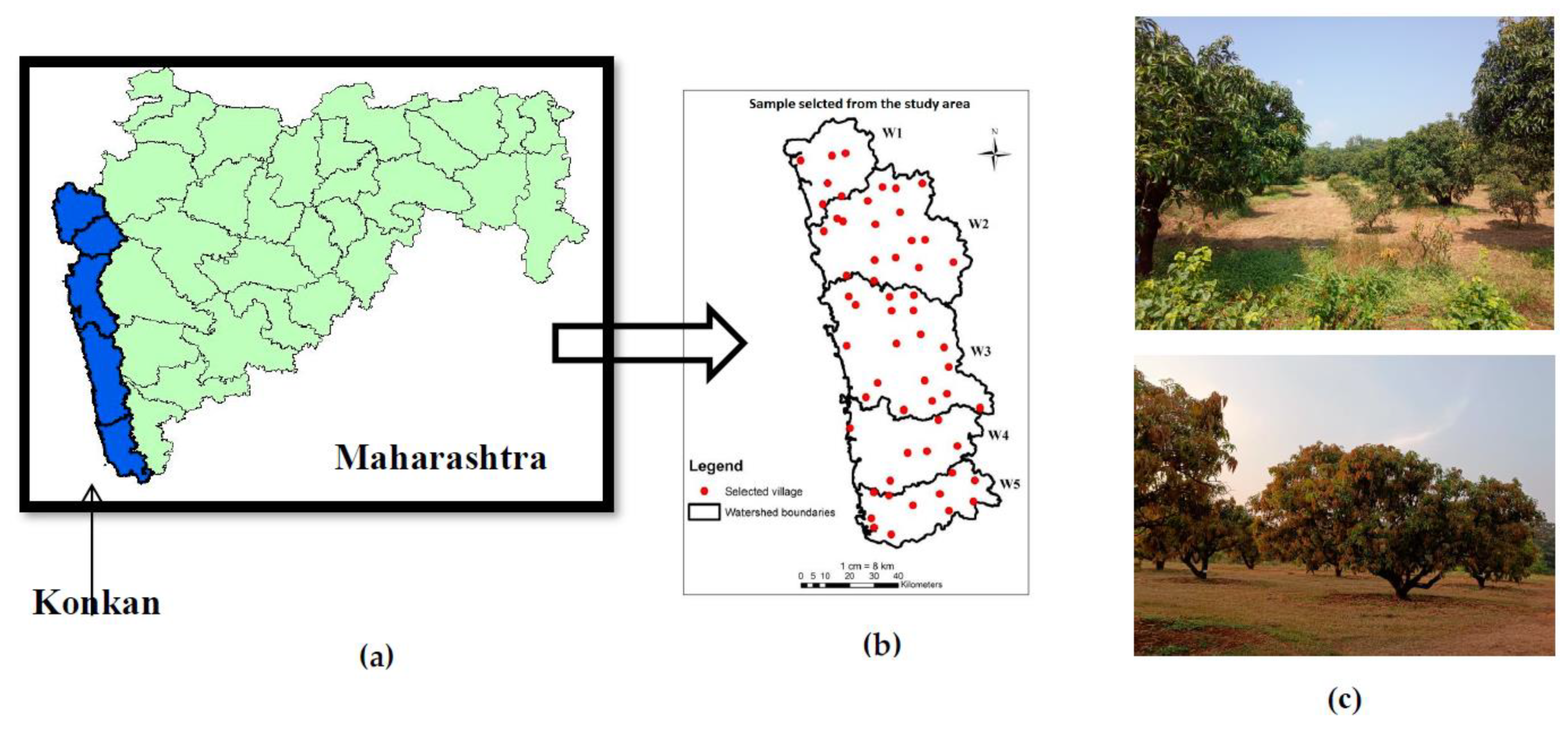
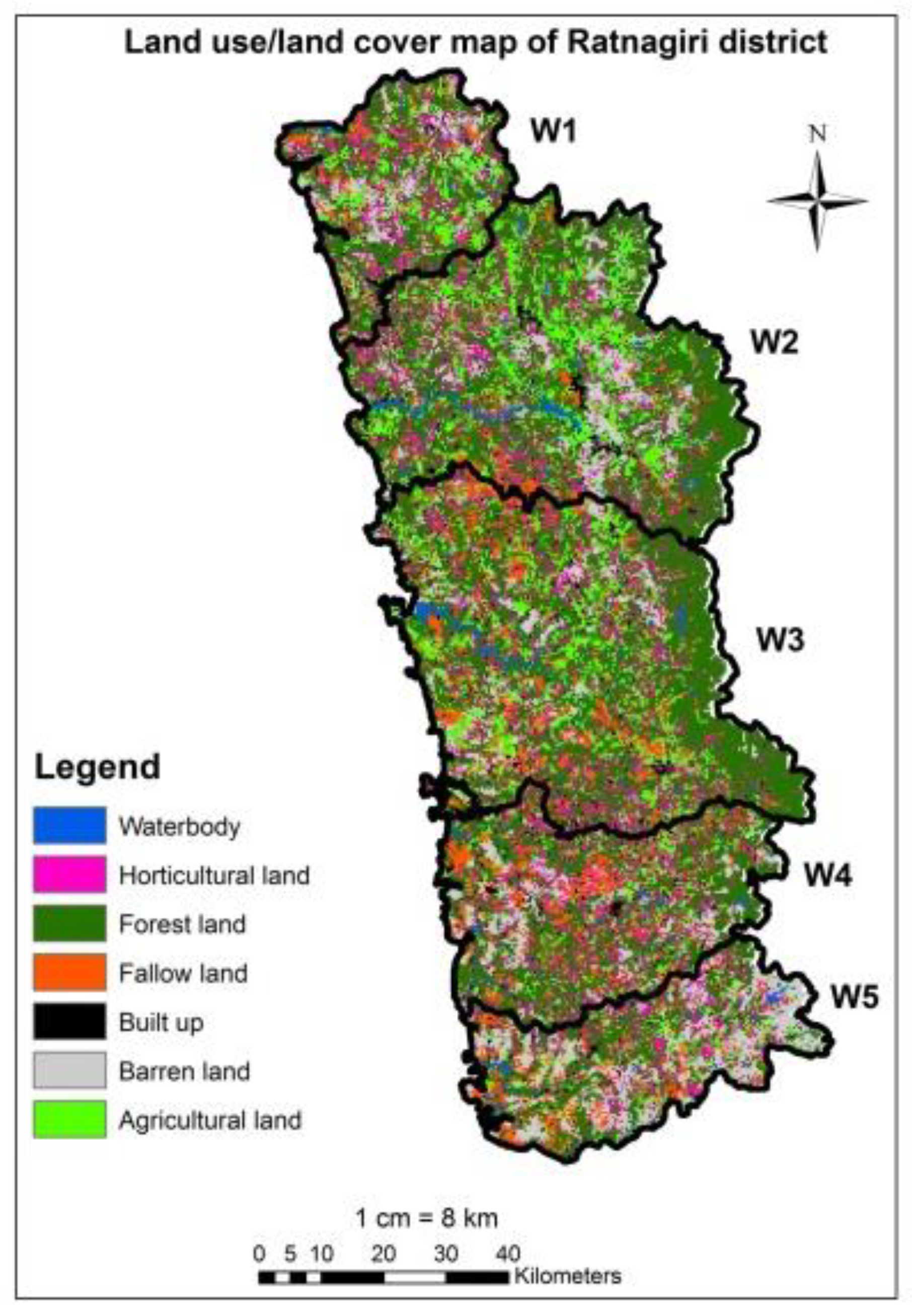
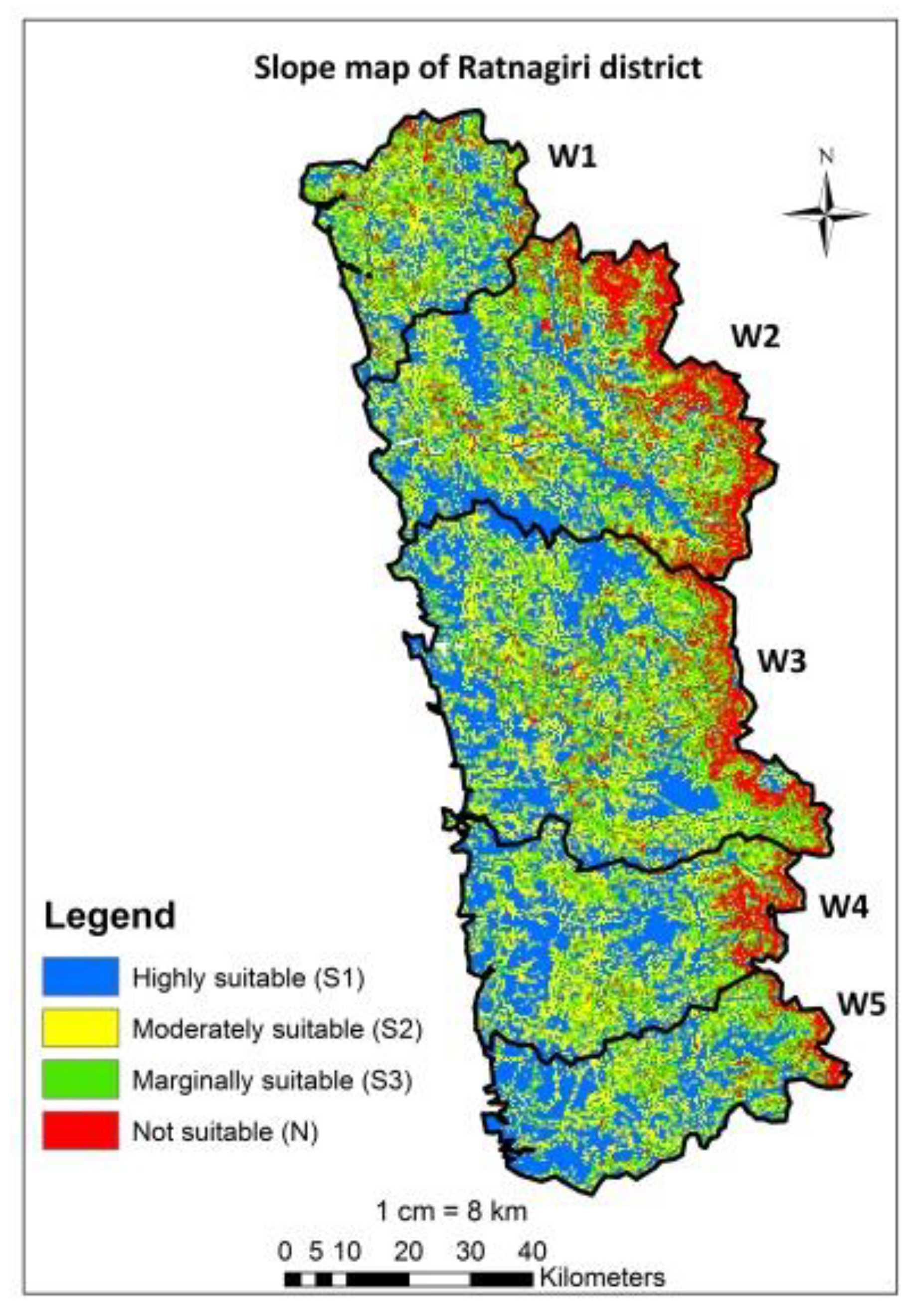
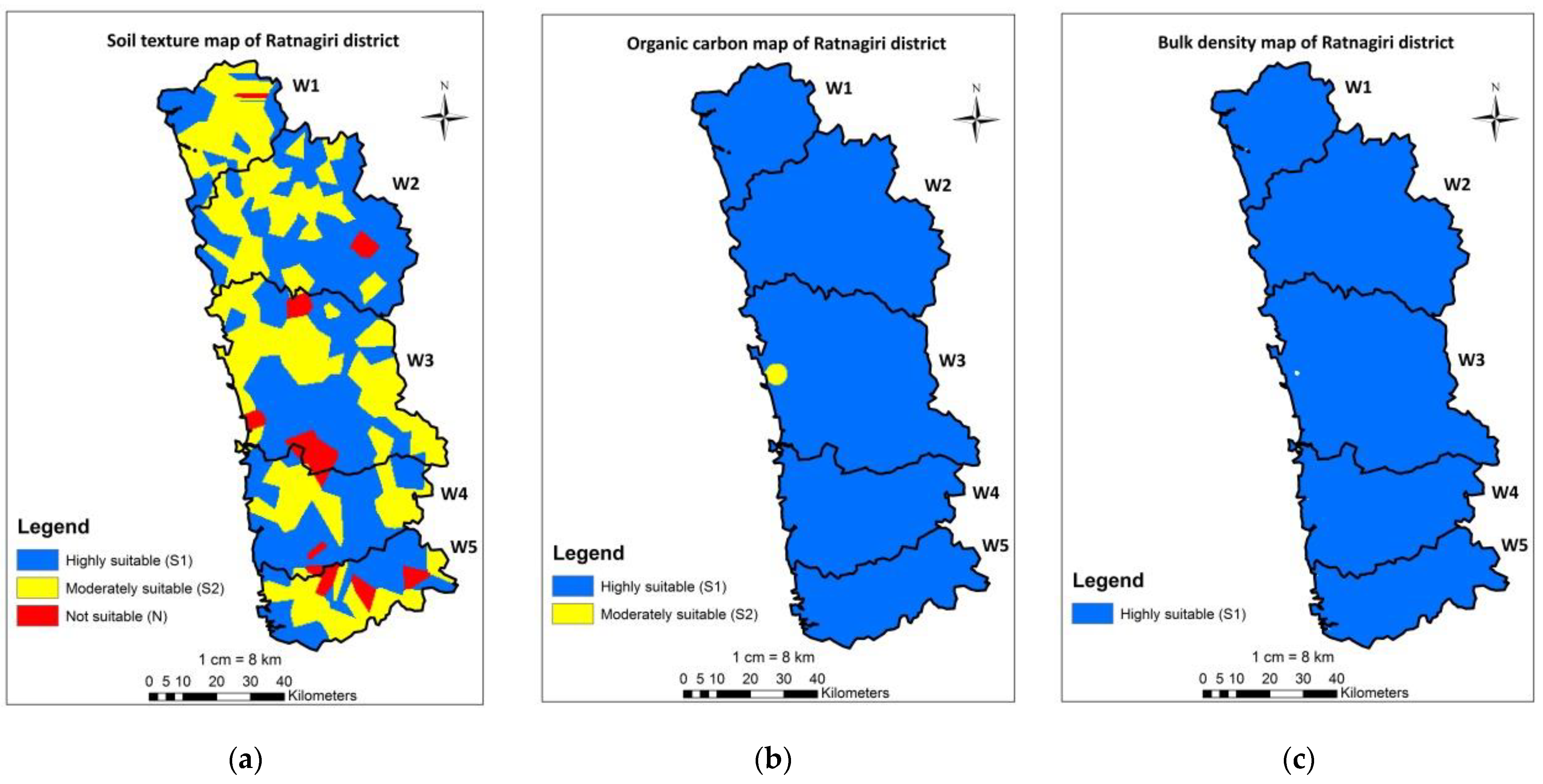
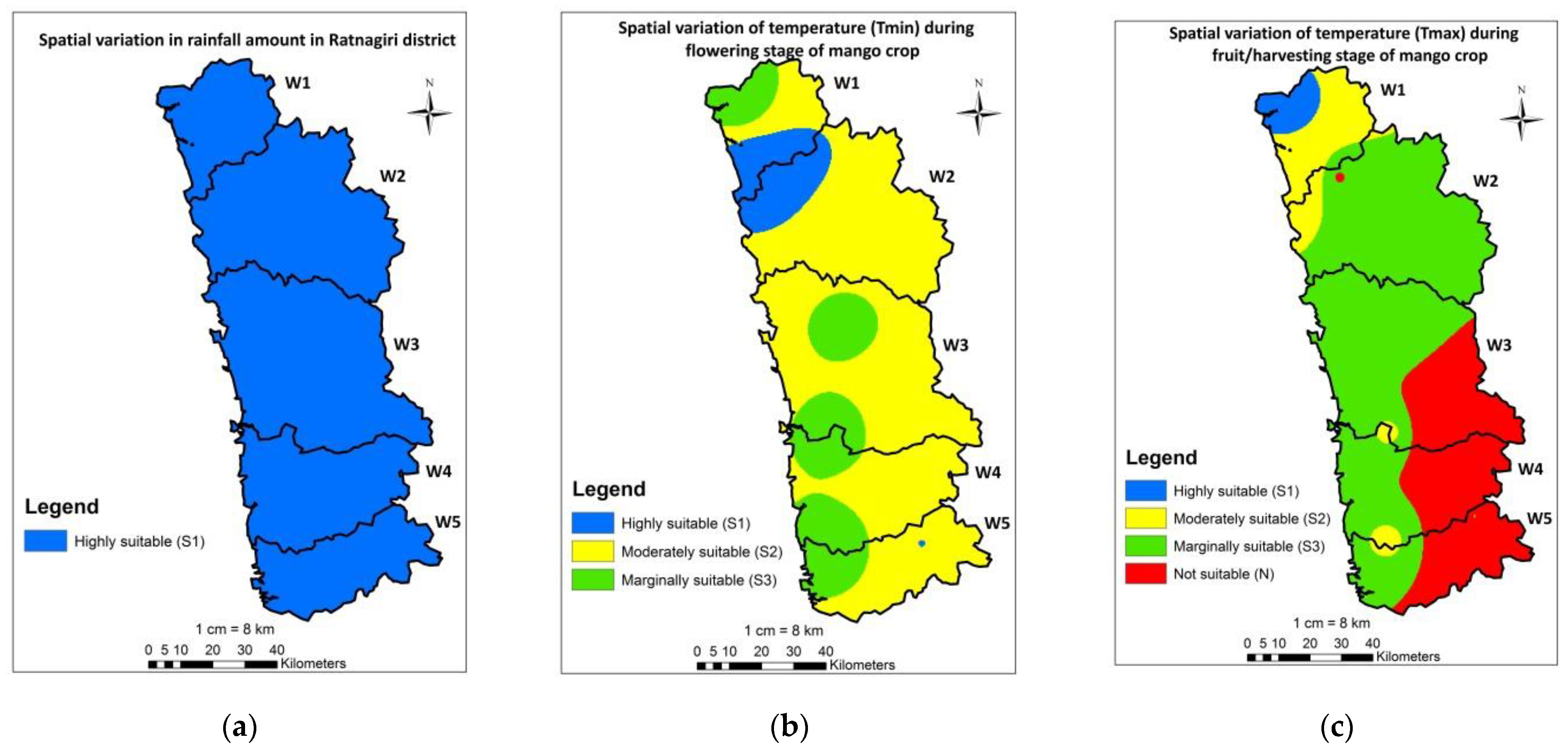

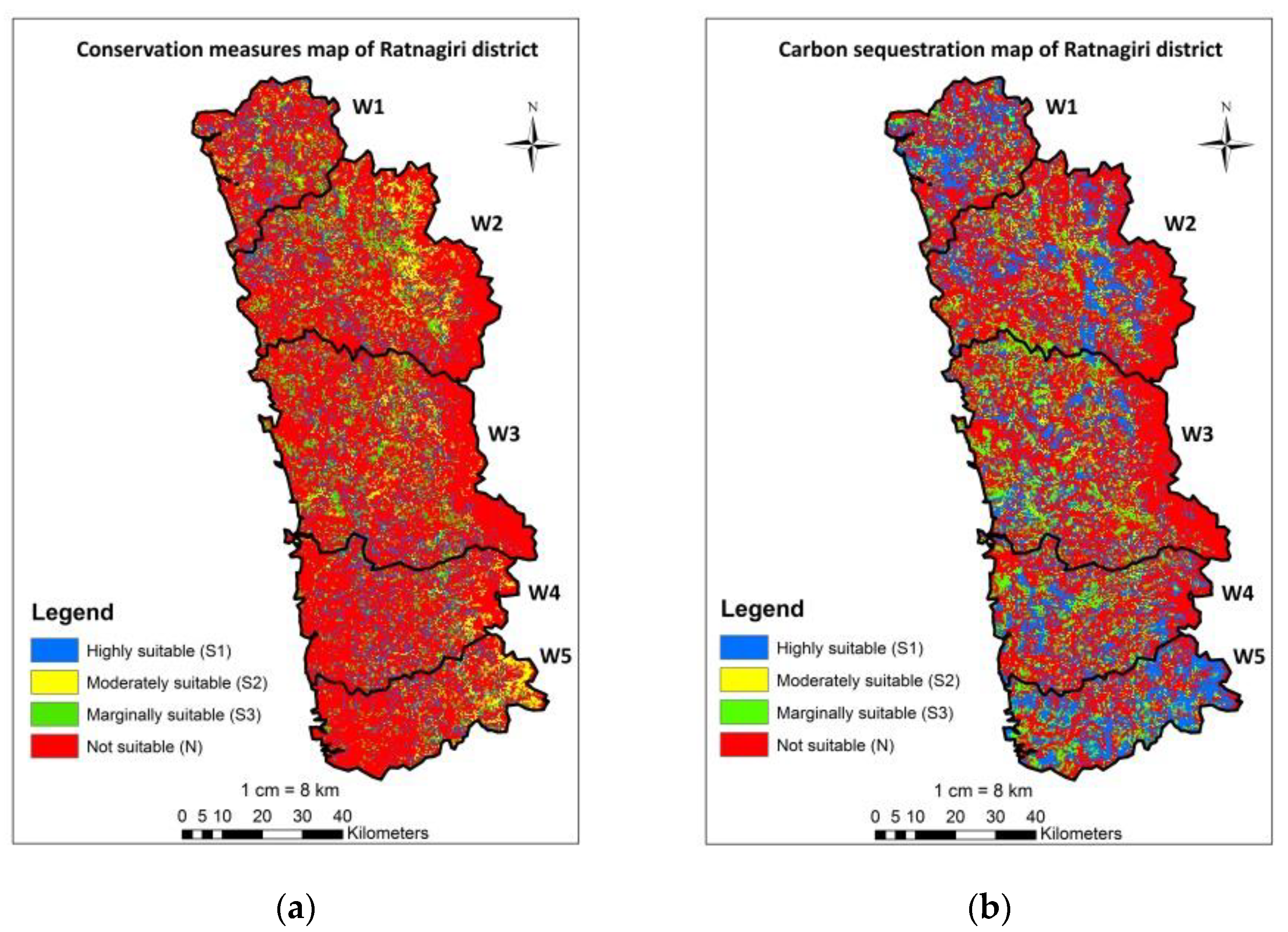
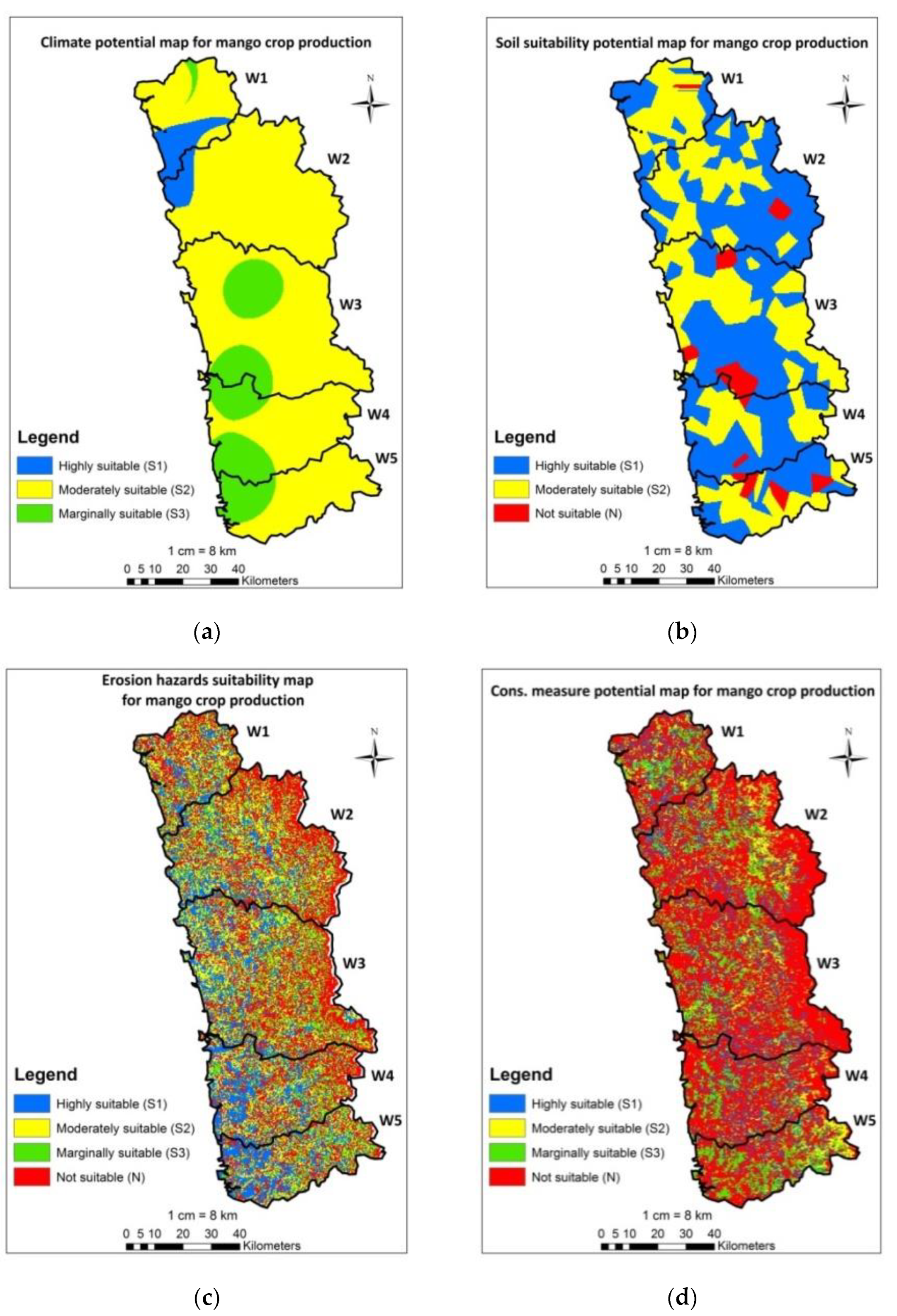
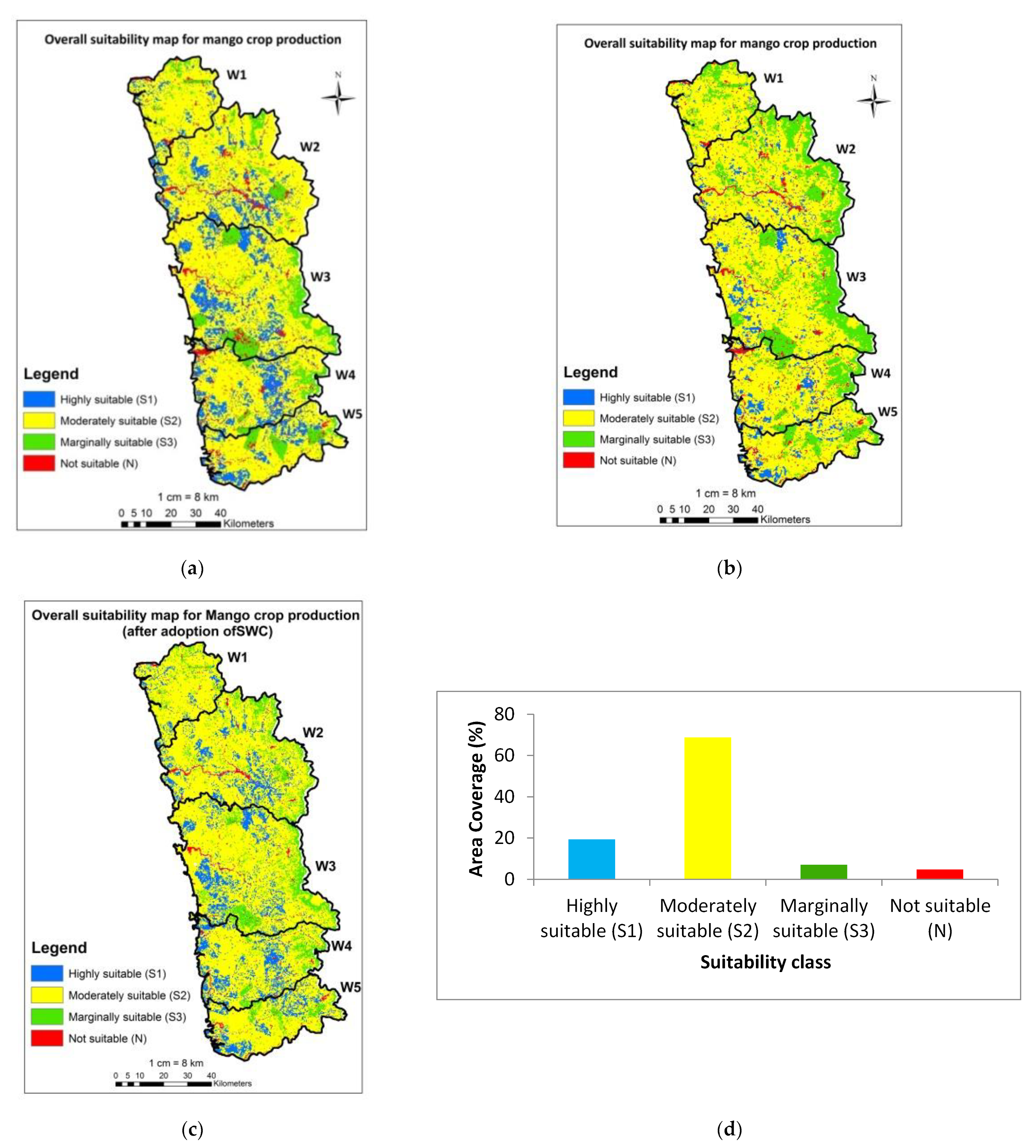
| Characteristics of the Soil | Unit | Rating | |||
|---|---|---|---|---|---|
| Highly Suitable Class, S1 | Moderately Suitable Class, S2 | Marginally Suitable Class, S3 | Not Suitable Class, N | ||
| Temp. in Flowering stage | Tmax (°C) | 28–32 | 30–32 | 32–35 | >35 |
| Tmin (°C) | 13–17 | 17–20 | 20–23 | >23 | |
| Temp. in Fruit growth/Harvest stage | Tmax (°C) | 30–32 | 32–34 | 34–35 | >35 |
| Tmin (°C) | 20–22 | 22–23 | 24–25 | >25 | |
| Temp.in Vegetative growth stage | Tmax (°C) | 25–27 | 28–30 | 30–35 | >35 |
| Tmin (°C) | 13–17 | 17–22 | 23–26 | >26 | |
| Average annual rainfall | mm | >2000 | 2000–1000 | 1000–500 | <500 |
| Texture | Class | Sandy clay, loam, silt loam, loamy sand | Sandy loam, sandy clay, silty clay, loam, clay (m/k) | Clay (sand < 60%) | Clay (sand > 60%), sand |
| Organic Carbon | % | High | Medium | Low | - |
| Bulk Density | g/cm3 | <1.60 | <1.40 | <1.10 | - |
| Slope | % | <8 | 8–16 | 16–30 | >30 |
| Soil erosion | t/ha/yr | Slight, moderate | High | Very high | Severe, very severe |
| Carbon loss | t/ha/yr | Slight, moderate | High | Very high | Severe, very severe |
| Conservation measures | Structure | Broad base terracing, Continuous contour trenching | Bench terracing, Staggered contour trenching, Stone bund | Strip cropping | Waterbody, Built-up, remaining area |
| Carbon sequestration | Structure | Fallow, terracing, trenching | Strip cropping | Barren | Waterbody, Built-up, remaining area |
| Criteria | PairWise Comparison Matrix | Weight | Consistency Ratio (CR) | |||||
|---|---|---|---|---|---|---|---|---|
| (1) | (2) | (3) | (4) | (5) | (6) | |||
| Climate sub-criteria | ||||||||
| Tmin flowering stage (1) | 1 | 3 | 5 | 63 | 8% | |||
| Tmax fruit/harvest stage (2) | 1/3 | 1 | 3 | 26 | ||||
| Rainfall (3) | 1/5 | 1/3 | 1 | 11 | ||||
| Soil sub-criteria | ||||||||
| Soil texture (1) | 1 | 2 | 3 | 54 | 1% | |||
| Organic carbon (2) | 1/2 | 1 | 2 | 30 | ||||
| Bulk density (3) | 1/3 | 1/2 | 1 | 16 | ||||
| Erosion hazards sub-criteria | ||||||||
| Soil loss (1) | 1 | 3 | 75 | 0% | ||||
| Carbon loss (2) | 1/3 | 1 | 25 | |||||
| Conservation measures sub-criteria | ||||||||
| Conservation measures (1) | 1 | 2 | 67 | 0% | ||||
| Carbon sequestration (2) | 1/2 | 1 | 33 | |||||
| Main criteria | ||||||||
| Soil (1) | 1 | 3 | 5 | 7 | 9 | 50 | 8% | |
| Slope (2) | 1/3 | 1 | 3 | 5 | 7 | 26 | ||
| Erosion hazard (3) | 1/5 | 1/3 | 1 | 3 | 5 | 13 | ||
| Climate (4) | 1/7 | 1/5 | 1/3 | 1 | 3 | 7 | ||
| Cons. Measure (5) | 1/9 | 1/7 | 1/5 | 1/3 | 1 | 4 | ||
| Criteria | V | Weight | Rank |
|---|---|---|---|
| Soil | 51.49 | 0.38 | 1 |
| Slope | 38.31 | 0.28 | 2 |
| Climate | 5.87 | 0.04 | 5 |
| Cons. Measure | 15.35 | 0.11 | 4 |
| Erosion | 25.06 | 0.18 | 3 |
| Total | 136.08 | 1.00 | - |
Disclaimer/Publisher’s Note: The statements, opinions and data contained in all publications are solely those of the individual author(s) and contributor(s) and not of MDPI and/or the editor(s). MDPI and/or the editor(s) disclaim responsibility for any injury to people or property resulting from any ideas, methods, instructions or products referred to in the content. |
© 2023 by the authors. Licensee MDPI, Basel, Switzerland. This article is an open access article distributed under the terms and conditions of the Creative Commons Attribution (CC BY) license (https://creativecommons.org/licenses/by/4.0/).
Share and Cite
Salunkhe, S.; Nandgude, S.; Tiwari, M.; Bhange, H.; Chavan, S.B. Land Suitability Planning for Sustainable Mango Production in Vulnerable Region Using Geospatial Multi-Criteria Decision Model. Sustainability 2023, 15, 2619. https://doi.org/10.3390/su15032619
Salunkhe S, Nandgude S, Tiwari M, Bhange H, Chavan SB. Land Suitability Planning for Sustainable Mango Production in Vulnerable Region Using Geospatial Multi-Criteria Decision Model. Sustainability. 2023; 15(3):2619. https://doi.org/10.3390/su15032619
Chicago/Turabian StyleSalunkhe, Sanjani, Sachin Nandgude, Mukesh Tiwari, Harshal Bhange, and Sangram B. Chavan. 2023. "Land Suitability Planning for Sustainable Mango Production in Vulnerable Region Using Geospatial Multi-Criteria Decision Model" Sustainability 15, no. 3: 2619. https://doi.org/10.3390/su15032619
APA StyleSalunkhe, S., Nandgude, S., Tiwari, M., Bhange, H., & Chavan, S. B. (2023). Land Suitability Planning for Sustainable Mango Production in Vulnerable Region Using Geospatial Multi-Criteria Decision Model. Sustainability, 15(3), 2619. https://doi.org/10.3390/su15032619








